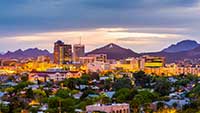HEAL of Southern Arizona

Air Quality in Tucson, Arizona
The ambient air quality in Tucson (and surrounding Pima county) is relatively good by standards monitored by the EPA (Pima County/EPA Air Quality). Many toxins problematic to those who are sensitive to chemicals, however, are not monitored by the air quality program, and given locations within the city may have specific air quality problems. Tucson is often considered a good location for those with MCS or allergies. That is not universally true, however, as several factors can contribute to health problems and should be weighed by those with MCS before choosing Tucson.
The Location of Tucson is in a topographical 'bowl', surrounded on the northeast, east, southwest, and west by mountains or hills. In the last decade, the town has grown to the northwest and south, the two directions where there are not mountains and public land blocking development. There are about one million people in the valley, depending on the season and who is counting. The elevation is 2,000-3,800 ft. Tucson is about 60 miles north of the Mexico border (topographic map of Tucson 'bowl').
The Climate is of course desert – Sonoran desert with five seasons: Early summer from mid-May to perhaps mid-July – hot and dry – very hot, lows at night in the 90's, most of the days 100 degrees or higher. The monsoon season from July or August to September is wet and hot (85 night-100 days) with much thunderstorm activity. Fall is usually clear with nice temperatures but can be rainy. Winter, December to mid-February, can be below freezing at night and around 50 in the day, most of Tucson’s rain is expected in the winter. Air inversions do happen in the winter. Spring is again a lovely season with average temperatures of about 70 but can be windy.
Industry and Agriculture are minimal. There is only small manufacturing, the electronic industry is present but not large (there had been groundwater contamination by IBM in the past). Agriculture is limited to a few remaining cotton farms 30 miles to the NW of Tucson, and a few remaining Pecan farms in the Green Valley area. There are, however, mines in the surrounding mountains. Copper mining is considered to be “king” in Arizona. There is a manufacturing industry to the south in Mexico, at the border. The largest industry in Tucson is Davis Monthan Air Force Base – there is a lot of air traffic. The airbase is pretty much right in the middle of the basin.
13 Air Quality Concerns in Tucson to consider if you have MCS or allergies.